Catalogue > Search
Results for : Tout le catalogue

Piotr Blajerski
UNCERTAINTY
Experimental fiction | hdv | black and white | 8:0 | Poland | 2014
The short film UNCERTAINTY is like Ouroboros, has no beginning and no end. The important aspect of the plot is constant change of the perspective between the observer and the observed person. This endless inversion and slow close-ups create the atmosphere of uncanny epidemic. Uncertainty is the effect of being infected by a microbe which forced a victim to intense observation of the surrounding world. The final aim is to not get concentrated on any specific element or quality but to exceed the cognitive habits. The suspended certainty of the existence forces all observers to look through the images of so-called reality. Their behavior may look absurdly, although it’s based on the promise given by our culture: there must be something beyond the visible world.
Born in 1980 in Wroclaw, Poland where he lives and works. Since 2004 studied at The Academy of Fine Arts and Design in Wroclaw. Received MA Degree in Media Arts in 2011. Founder and director at EMDES gallery which existed between 2009 and 2011.


Philippe Blanchard
Taco Monde
Animation | dv | color | 2:30 | Canada | 2005
An animated exploration of the popular fast food culture of North America, mixing the absurd with the obsessional and addressing other themes, such as the sensorial overload and the omnipresence of the interactivity in the media.
Trained in cinema and fine arts at Concordia University (Montreal, Canada), Philippe Blanchard worked for a few years in Latin America and the Middle East. He eventually followed a training program in special effects at Seneca College (Toronto). He currently works for the animation studio 'Head Gear Animation' in Toronto.
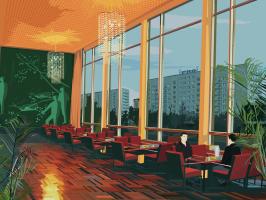

Vicente Blanco
The Proll Thing
Animation | dv | color | 3:27 | Spain | 2006
The project ?The proll thing? comprises an animated video on two screens, and a video recorded with a handy phone. The idea is to distribute the narrative into different media, and see how this information acquires diferent levels in the exhibition space. My starting point was the Kino International restaurant in East Berlin. This building?s current ?image policy? prohibits taking photographs inside of it (although it is open to the public during film screenings). I thought about animation as the medium to depict the inside of the building, since it would be possible to recreate the interior in such a way as to mix reality and fiction. To make this setting, I integrated different elements, some of them real, others imaginary, creating new situations. The drawings for the video?s sets were based on a series of postcards which are sold as souvenirs at the entrance to the cinema. I was interested in the relationship between my own experience (looking in from an outside entrance to the building, from which I could see the tables closest to its picture windows) and the visual information contained in the postcards. Now, what is happening in a city like Berlin is that the recent past maintains a presence through many symbols (the monuments to Russians fallen in World War II, the telecommunications tower, the wide boulevards) I am interest in the moment, right now, when these symbols? usages are changing very quickly. The old Café Moskau, where the communist elite used to pamper itself, is now a gay disco; the old Palace of the Republic, used for skateboard competitions. Although at first, these where spaces created to establish doctrines, today, with the rapid adjustment of these uses and symbols, they are producing new meanings, maintaining their nature as social places, for meeting or exchange.
Vicente Blanco was born in Cee (A Coruña),Spain, and graduated in Fine Arts at the Faculty of Pontevedra (University of Vigo). He has been awarded the following grants, among others, a scholarship to further his training at the CGU in Los Angeles (U.S.A.), a Generation 2000 project grant awarded by Caja Madrid and the Unión Fenosa Grant and Beca Endesa, which allowed him to live in Berlin. He has taken part in numerous group exhibitions, most notably in Transfer 2000-2001, which, following a spell at the CGAC, toured various Spanish and German cities, Monocanal at the MNCARS, in the year 2003, Enlaces at the Museo Patio Herreriano in Valladolid, in 2004, as well as in a variety of shows in 2006, such as, Urbanitas in MARCO (Vigo), ¿Viva pintura! In Salzburg (Austria) and 16 x 16, 16 proyectos de arte español, curated by María de Corral for ARCO?06. His main solo exhibitions were held at the CGAC in 2003 (Lo que se espera de nosotros) at the Espacio Uno of the Reina Sofía Museum ?MNCARS? in 2004 (Alguna vez pasa cuando estáis dormidos) and at the Elba benitez Gallery (Otra vez algo nuevo), 2006.
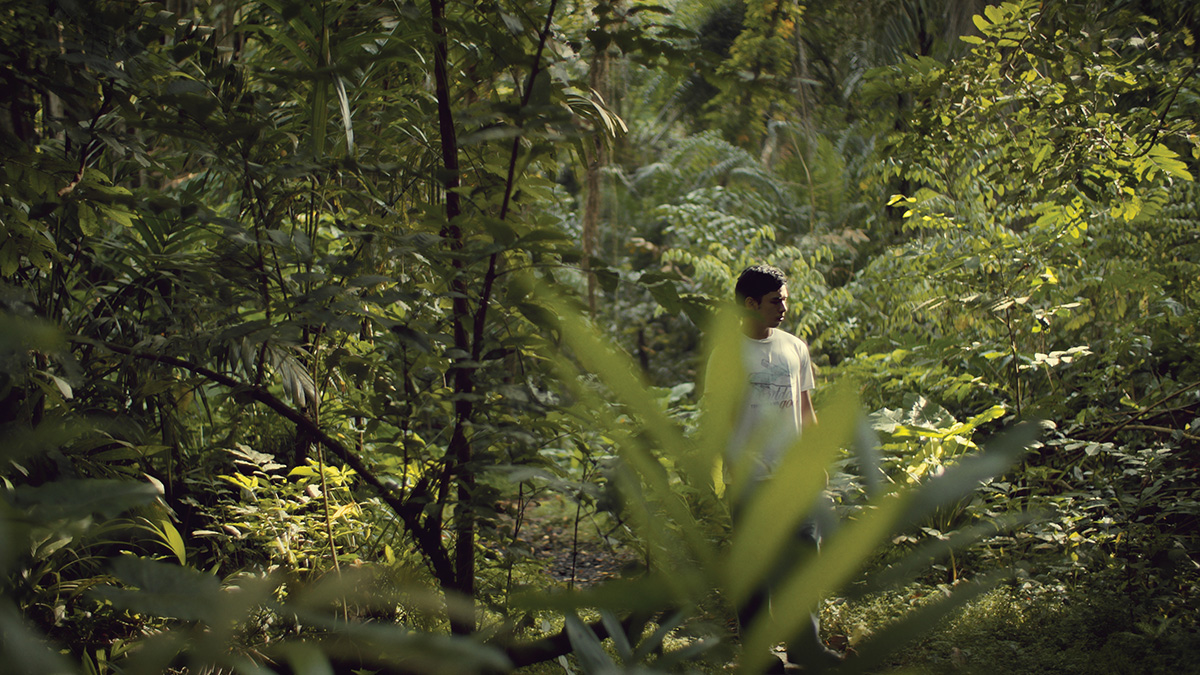

David Blandy
Empire of the Swamp
Experimental video | 4k | color | 15:21 | United Kingdom, Singapore | 2023
Empire of the Swamp (2023) begins with a figure wandering from the mangrove swamps surrounding the city edges of Singapore to Bukit Brown Cemetery in the heart of the island, overgrown and rich with biodiversity, once the final resting place for 100, 000 people. This green space is slowly being swallowed up, graves exhumed to make way for new roads and eventually new housing. A script, written by playwright Joel Tan, is a fable of nature and the repercussions of colonialism. A tale of a crocodile who comes upon the soul of a English soldier lost in the swamps. Empire of the Swamp was part of Atomic Light, David Blandy’s most ambitious solo project to date at John Hansard Gallery, Southampton, UK. Featuring four newly commissioned films, it builds upon his continued interest in history, the legacy of empire and the climate crisis. The tales interconnect through the story of Blandy’s grandfather, a British soldier interred in Singapore as a Japanese prisoner of war, who believed that the horrific atomic bombing of Hiroshima saved his life. Empire of the Swamp was commissioned by John Hansard Gallery, UK & Supported by Arts Council England
David Blandy (1976, UK, Lives & works in Brighton) makes work that slips between performance and video, digital and analogue, investigating the stories and cultural forces that inform and influence our lives. Collaboration is central to his practice, examining communal and personal heritage and interdependence. With research spanning multiple forms of archive, from fandoms to the archive of the body, historic texts to academic libraries, archaeology and ecological theory, twitch streams and film archives, Blandy weaves poetic works that explore the complexities of the contemporary subject. He is represented by Seventeen Gallery, London, UK. His films are distributed by LUX, London, UK.
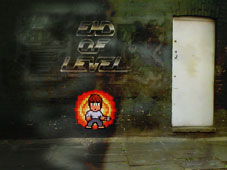

Viktor Blanke
End of Level
Animation | dv | color | 7:15 | Sweden, United Kingdom | 2005
End of Level is a short animated piece, fusing 2D pixels with 3d animation. The grande battle between an street artist and art director progresses to the soundtrack of beats created with a Nintendo Gameboy. The pixelated men battle for supremacy through reproduction, subversion, adbusting and recuperation. Reconfiguring the city`s system of signs is an epic battle which will never end.
Victor Blanke was born in Stockholm, Sweden in 1980. A graduate of Central Saint Martins College of Art and Design and the Stockholm Filmschool, his work has been shown at the Stockholm Film Festival, the Subörb Festival and publications such as The Face and Adbusters Magazine. His commercial work includes numerous music videos and adverts for artists such as Paul McCartney, Shelly Poole, Håkan Lidbo and mutagene.

Daniel Blaufuks
Levantados do Chão
Experimental doc. | hdv | color | 20:0 | Germany, Portugal | 2018
A traditional band plays in an abandoned hotel on an island in the middle of the Atlantic Ocean. Only in the final credits we understand that this is a political film.
Daniel Blaufuks uses mainly photography and video, presenting his work through books, installations and films. He has a predilection for issues such as the connection between time and space and the intersection between private and public memory.


Max Bloching
Tomorrow, the Burning Heavens
Experimental doc. | digital | color | 22:0 | Germany | 2024
1560: the beginning of the so-called ‘Little Ice Age’. Uncanny celestial events ignite the skies over Germany and Switzerland, leading people to believe the world is ending. ‘Tomorrow, the Burning Heavens’ reconsiders these apocalyptic visions, once captured in hand-colored woodblock prints, and returns to the Alps to observe the industrial production of winter landscapes in a modern-day skiing resort. Here, past and present dreams and nightmares are melted together in a film about the interplay of image-making, technology and faith during times of environmental collapse.
Max Bloching (b. 1994 Germany) is an artist filmmaker and sound recordist based in Berlin. Max´s work is animated by an interest in participatory forms of filmmaking and a curiosity in the ways humans experience and imagine the world through sound and silence. Max`s work has been shown internationally at places such as APT Gallery London, Visions Du Reél and RAI International Festival of Ethnographic Film where he received the Willey Blackwell Student Film Prize. Max holds a BA in Social Anthropology from SOAS and an MA in Artists Film and Moving Image from Goldsmiths University of London.

Beth Block
Successive Approximations to the Goal
Experimental film | hdv | color | 14:11 | USA | 2015
Successive Approximations to the Goal (2015), 14 min., 1080p digital Successive Approximations to the Goal is a term that is used in applied behavior analysis. It refers to the series of slight behavioral changes that are reinforced because they are increasingly more similar to the ultimate objective. Driven by the desire to spatially portray the passage of time, I filmed an LA Galaxy/Vancouver Whitecaps soccer game and then composited the images to portray the motion over time of the players, the refs and the ball. As the different pieces emerged, I was struck by the inevitability and futility of what I was seeing, which triggered in me thoughts of rats in cages, endlessly pushing rocks up mountains, video games that you always lose and the paradox of the movement of electrons. The sound interprets, in many different ways, the possible explanations for such strange human behavior.
Beth Block is a media artist who lives in Los Angeles. She worked in the film industry creating visual effects for major Hollywood films including TERMINATOR 2, ALTERED STATES, and JAMES AND THE GIANT PEACH and was among the first generation of artists to transition from cameras to computers to create visual effects. Her recent films exploit the ability of digital technology to be re-photographed multiple times without generational loss, enabling her to more fully explore her fascination with capturing motion depicted over time. In addition to her experimental films she is a freelance documentary director, cinematographer and editor. She currently teaches at USC’s School of Cinematic Arts and is also documentarian for the Unusual Suspects Theatre Company and the NewTown Pasadena Foundation. Her films and installations have been exhibited at Los Angeles Contemporary Exhibitions (LACE), The Cinematheque, San Francisco, Los Angeles Filmforum, Film in the Cities, Minneapolis, MN, and the Ann Arbor, Sinking Creek, Philadelphia, Athens, and Black Maria Film Festivals. Block was a founding member and former board president of the NewTown Pasadena Foundation, where she is still an active member, and from 1985-1995 was a Los Angeles Filmforum board member and past president.
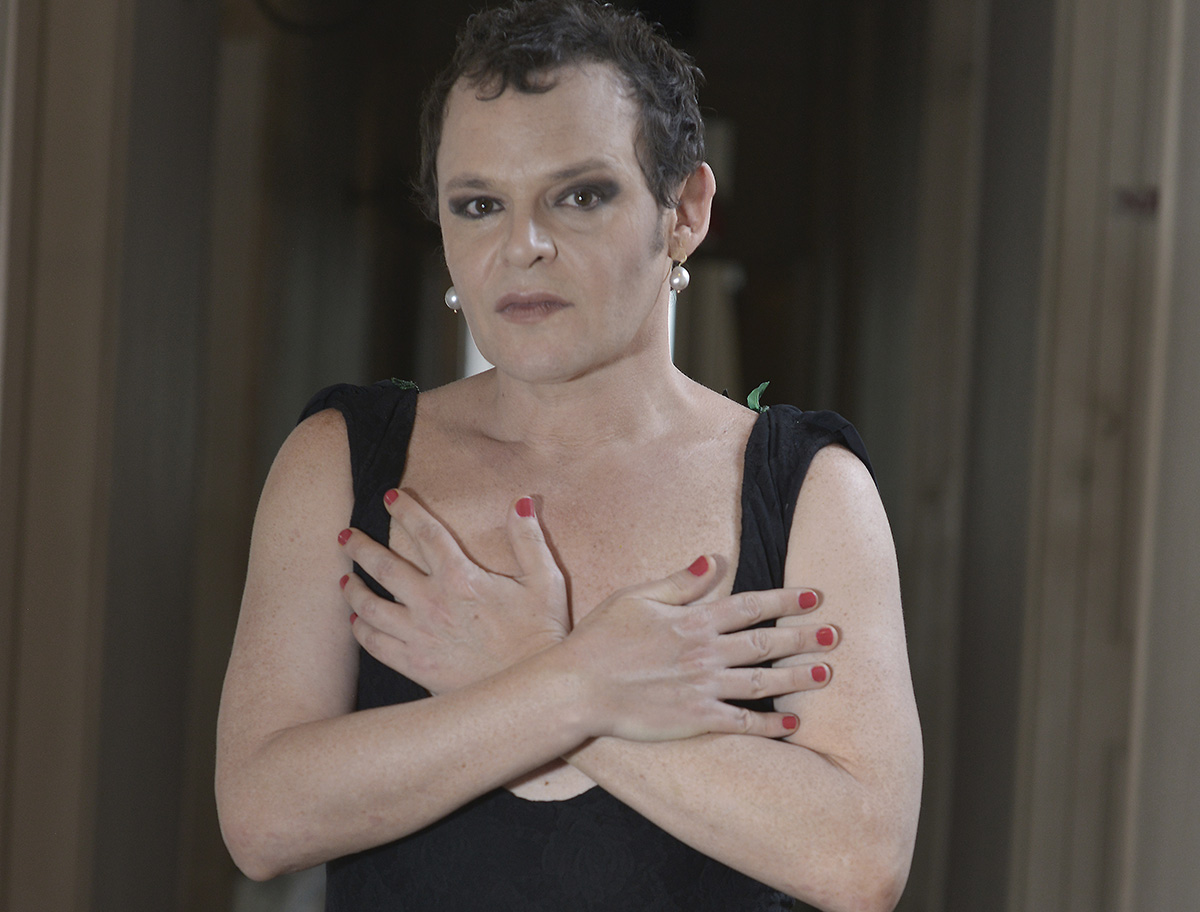

Diana Blok
Gender Monologues
Video installation | 4k | color | 34:49 | Netherlands, Brazil | 2016
The installation consists of twelve filmed life-size portraits of actors viewed on six screens, each impersonating their favourite character of the opposite sex, performed in six-minute monologues. In total the installations lasts 72 minutes. The monologues are extracted from, or inspired by lines delivered by iconic characters in drama and literature, both historical and contemporary, criss-crossing time, space and language. During the 72 minute-installation all actors remain visually present, while only one voice speaks at a time. Between silence and the spoken word, the intrinsic tension of male/female border zones is redefined. The result is multidimensional: portraits of our time containing speeches and visions that bring revealing thoughts and insightful conversations about identity, revolution and desire in what feels like a personal confrontation with each actor. We challenge static, mental and cultural conventions by giving back the imagination to the limitations on gender and sexual identity.
Diana Blok is a self-taught visual artist born in Montevideo, Uruguay (1952), she lived in Mexico, Guatemala and Colombia before choosing Amsterdam as a base from which she could function more freely as a female artist. Her nomadic background allows Blok to capture different cultures and identities in her photography and video installations, challenging the structures of the established order as an inspirator, innovator and connector. She investigates subjects as identity, gender, sexual diversity, family structures and culture with poetic and confrontational imagery. In the past 6 years her work evolved into interactive-video installation ’Gender Monologues’, unsettling the gender binary and performing archetypes of femininity and masculinity blurring the disciplines of the moving image, performance and literature. She has had numerous exhibitions worldwide, received the grant for Established Artist from the Mondriaan Foundation in 2020 and will hold a retrospective in the Cobra Museum for Modern and Contemporary Art (NL) in 2024.
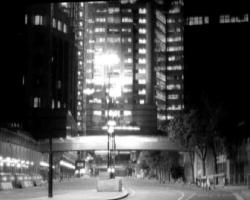

Ansuya Blom
Hither come down on me
Experimental film | 16mm | black and white | 11:15 | Netherlands | 2007
SYNOPSIS Hither come down on me Ansuya Blom 2007 Hither come down on me is the third and last film in the series ?Cowboys and Indians?. Just as in the two previous parts, Chapter Three and Nervous, anxiety is the main focus. It is through a ?touch by language? that experience is guided in an auditory way. In Chapter Three the view of the ?first person singular? is distorted through the experience of the space, while in Nervous the soothing environment of nature can be seen as a doubble negative, whereby it isboth familiar and the unfamiliar. In Hither come down on me anxiety is evoked through the confrontation with the external world of the city, quite literally what is outside the domestic. The protagonist experiences what he sees and hears as a direct form of communication, speaking directly to him and ordering him. As opposed to previous parts the main character can be seen, if only in a fragmentary way through the reflection of a mirror. He observes himself just as he experiences the outside world. The title of the film comes from an anonymous Native American poem, in which there is a plea for protection and change. In Hither come down on me the main character prepares himself mentally and physically for leaving his room, his controlled zone. His preparations consist of dressing meticulously. Everything is executed in a precise manner: buttoning a shirt, doing his cuffs, his trousers: a kind of mental ?warming up?. When the moment arrives to leave, a ritual is set in place in order to tame the situation. Once outside it is evening and he enters a world which is visually shadowy and auditorally dissociated. Language becomes more abstract, at times incomprehensible. The city becomes the voice speaking to him in a language into which he merges.
Ansuya Blom has been working as an artist since ?77, with drawing and film. In her work her focus is on the individual and his relation to his internal as well as the external world. ?The first person singular? is used by way of thinking about the individual and his relation to the world. In her films the world is seen through the protagonist?s eyes and heard through his voice. In her work Ansuya Blom?s interest lies within the strategies the individual adopts in order to deal with anxiety. Her work has been exhibited extensively in both galleries and museums in the Netherlands as well as abroad. Solo-exhibitions of her work including both drawing and film have held at Camden Art centre, London, Douglas Hyde Gallery in Dublin, and the Stedelijk Museum in Amsterdam. The Museum of Modern Art in New York has been among the venues where her films have been screened.
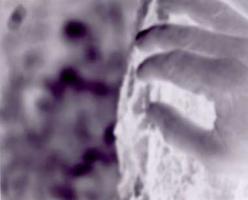

Ansuya Blom
Nervous
Experimental video | dv | black and white | 9:21 | Netherlands | 2004
A short film based on the story by Robert Walser. He describes his state of mind, which floats somewhere between optimism and hopelessness. Thoughts are read out loud during a walk in the country. Slowly nature turns into inner nature.
Ansuya BLOM (Groningen 1956) studied from 1973-74 at the Royal Academy in The Hague and from 1974-76 at the Ateliers `63 in Haarlem. Her paintings have been put on show at the Stedelijk Museum in Amsterdam, among other museums. She has also taken part in various international group exhibitions.
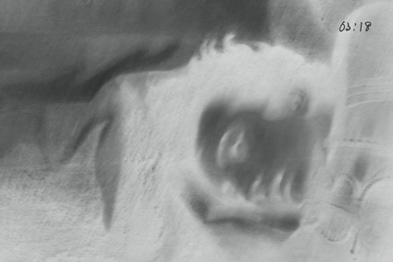
Ansuya Blom
SPELL
Video | hdv | black and white | 6:31 | Netherlands | 2012
SPELL is a short video documenting the thoughts of a man who seems to be in a state between sleep and wakefulness. The sounds he hears within the space where he lives seem to invade his thoughts and get amplified. They mix with associative sounds from his past. Meanwhile the reality around him appears to deform at times. In this in-between world he tries to het a grip on his state, contemplating early beginnings but at the same time mocking his own state, the futility of actions and the daily rituals of existence. The images for this film were shot in the Doesburg Foundation in Meudon, during a residency in 2010 - 2011. The house, with it`s historic past bore many traces from history and the people that had stayed there. This absent presence was a motivating factor in making this film. The words of Franz Kafka speak for themselves and it was the strange mix of humour and despair that attracted me.
Biography Ansuya Blom Ansuya Blom works as an artist using the media of drawing and film. Her work focuses on the individual and the relation to the internal as well as the external world. ?The first person singular? is used by way of thinking about the position of the individual. Ansuya Blom is interested in the strategies this individual adopts in dealing with anxieties that are induced by alienation. In her films the world is seen through the protagonists` eyes and heard through their voices. Ansuya Blom`s work has been exhibited extensively in both galleries and museums in the Netherlands as well as abroad. Solo-exhibitions of her work have been held at Camden Art centre, London, Douglas Hyde Gallery in Dublin, and the Stedelijk Museum in Amsterdam. The Museum of Modern Art in New York has been among the venues where her films have been screened. She is an advisor at the Rijksakademie van beeldende kunsten in Amsterdam.
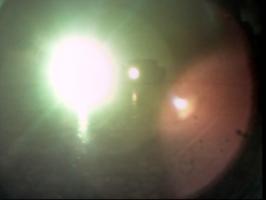

Maria Blondeel, Michael VORFELD
Wireless, Even Through Walls
Experimental video | dv | color | 9:0 | Belgium, USA | 2005
A Video improvisation with two Kodak Ektagraphic III E Plus slide Projectors with pax and transpax; connection for external control, FM oscillators with light sensors, square wave generators, FM receivers, a video projector, a digital recorder and a video lens operated by Maria Blondeel; green incandescent lamps, different light bulbs, a fluorescent tube, microphones, pick ups and various electric devices performed by Michael Vorfeld. Recorded at Hyde Park Art Center, Outer Ear Festival of Sound, ESS, Chicago, Illinois USA 2002 Produced by Blondeel/Vorfeld 2005
As a performing duo, Blondeel/Vorfeld has been operative since 1996: one an electronic sound artist and the other a percussionist, one projecting light and the other using light sources almost as objects. What one hears and sees is a contrapuntal dialogue between light controlled square waves and analogue, electric sounds accompanying or accompanied by a visual happening of light projected onto and into light, bright white and incandescently coloured yellow, blue or red. Maria Blondeel is an intermedia artist based in Ghent, Belgium. She has made sonic light installations, and site-specific works for vehicles, telephone and radio, participated in concerts and performances in collaboration with musicians, and produced works for CD and video. Her work has been shown in galleries, museums and festivals in Europe, the U.S.A. and Asia. Michael Vorfeld, based in Berlin, is a musician and visual artist. He plays percussion and self designed stringed instruments and works in the field of experimental music, improvised music and sound art. Realisation of electro acoustic sound pieces. His visual work concentrates on the use of light. He realizes light installations and performances with light, often site specific and in combination with instrumental or electric sounds. His list of activities includes numerous concerts, performances and exhibitions in Europe, the USA, Asia and Australia.
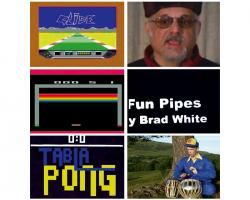

Jaygo Bloom
Continue play?
performance | dv | color | 5:46 | United Kingdom | 2005
`CONTINUE PLAY?` is part of an ongoing series of gaming inspired projects and presents to you the popular 80`s arcade classics `BREAK-OUT` `ELEKTRAGLIDE` and `PONG` with enhanced AV accompaniment. JAYGO BLOOM`S particular `gameplay` technique provides the structure and tempo for an alternative Audio Visual response, one that is constructed from equally misguided and randomly downloaded `home music tutorials`.
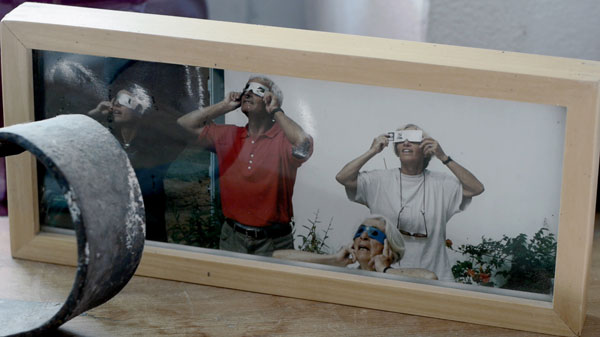
Ramon Bloomberg
Glacis
Video | hdcam | color | 35:7 | United Kingdom, France | 2013
Glacis The film explores the remnants of the French bourgeoisie, a world slowly but inexorably undermined by the forces of acceleration and globalised finance capitalism. dividing the sequences are still frames taken from the history of French aviation, the developments of which were a particularly bourgeois pastime of the 18th and 19th centuries enabled by family industrial infrastructure. The notions of speed and acceleration associated both with flight and post industrial capital are contrasted to slowness and investment associated with bourgeois values and the old industrial elites. Self professed Bourgeois are filmed in their family (secondary) homes performing role playing games that they themselves have chosen. These sequences are followed by "cinematic" sequences designed by the performers and produced by the film maker. The French aviation threads that bookend the chapters are accompanied by a narrated voice and composed of a single frame image. That image degrades over time. The degradation of the image is a result of algorithmic scripting that obliterates the traditional notion of decay by performing in fast forward, 1,000 years of the opening and closing of a jpeg image until the image itself is degraded to the point of being unrecognisable. This process formally performs the undermining - by technologies - of the temporal weapon of tradition and manners mobilised in the project of bourgeois hegemony. Glacis is an ancient military term that denotes a field of view unimpeded by obstacles where the enemy other is clearly visible, figured against the nothingness.
Ramon Bloomberg: Biography: Born 1971 Sheffield, United Kingdom. French / British nationality. Worked extensively as a film editor and film director on projects from fiction to documentary to music video and commercial. Currently PHD candidate Art Research, Goldsmiths College, London.

Felix Blume
Luces del Desierto
Experimental video | mov | color | 29:50 | France, Mexico | 2020
Some strange lights appear at night in the Mexican desert. The residents tell us what they’ve seen: fire, a fireball, lights flying, lightning falling from the sky and a flash. The singularity of each experience builds a complete story narrated by a choir of people. An encounter with this strange phenomena can be surprising, dangerous or even fatal. The night isn’t as dark as it seems. The desert is full of all kinds of living beings. This emptiness is the place for everyone. Desert Lights invites us to open our eyes wide in the twilight and to listen to the sounds hidden in the blackness. A horror movie, in the darkness of the desert.
Félix Blume (France, 1984) is a sound artist and sound engineer. He currently works and lives between Mexico, Brazil and France. He uses sound as a basic material in sound pieces, videos, actions and installations. His work is focused on listening, it invites us to a different perception of our surroundings. His process is often collaborative, working with communities, using public space as the context within which he explores and presents his works. He is interested in myths and their contemporary interpretation, in human dialogues both with inhabited natural and urban contexts, in what voices can tell beyond words. His sound pieces have been broadcasted in radios from all over the world. He has been awarded with the “soundscape” prize for his video-piece Curupira, creature of the wood and the “Pierre Schaeffer” prize for his work Los Gritos de México at the Phonurgia Nova Awards. He has participated in international festivals and exhibitions as LOOP Barcelona (2015), CCCB Barcelona (2015), Tsonami Arte Sonoro Chile (2015, 2018), Fonoteca Nacional Mexico (2016), Ex Teresa Mexico (2016), CENTEX Chile (2017), CTM Berlin (2017), Belluard Festival (2018), Arts Santa Monica Barcelona (2018), Thailand Biennale (2018), Berlinale (2019) and Rotterdam IFF (2021) among others.
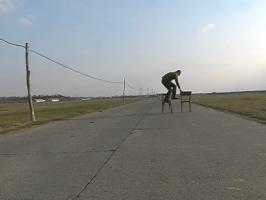

Florin Bobu
Best Man
Experimental video | dv | color | 1:20 | Romania, Serbia | 2007
An off-camera narrator is announcing the following: ?In Serbia, the Best man can ask for everything. He can even ask to cross the street on chairs.? A character brings along a pair of wooden chairs and begins exemplifying the unusual off-camera announcement by crossing the empty road on the two chairs. Having that done, the character exits the scene carrying the two chairs.
Florin Bobu is a visual artist and an independent curator. He graduated from the Faculty of Visual Arts and Design (A.K.I.) in Enschede (The Netherlands) in 2005 and has participated in a number of artistic events in The Netherlands, Germany, Belgium, France and Romania. Florin Bobu was born and lives in Tecuci, Romania. His interests in performance and video art remain linked with his beginnings in visual arts: photography. As a consequence, his artistic practice is systematically fragmentized into short actions that could easily remind of the actions of a photographer, especially a street photographer, but also relate to the ways in which one reacts in front of a complex situation. To deal with such situations mostly involves breaking them in less complicated parts which are dealt individually and successively.

Raphaël Boccanfuso
Copyright (mise en vente)
Video | dv | color | 1:30 | Switzerland, France | 2007
Enregistrement de la mise en vente des droits de propriété et d`exploitation du verbe "avoir" à Drouot-Richelieu par Cornette-de-Saint-Cyr.
C?est au travers d?une attitude que l?oeuvre plurielle de Raphaël Boccanfuso trouve sa problématique d?ensemble, une attitude amusée et provocante qui met au défi toutes sortes de schémas référentiels. Son travail n?est pas d?ordre biologique, sa méthode relève pourtant d?un mode de processus viral. S?insinuant dans les failles de codes exigus, elle se plait à forcer les limites toujours trop marquées de systèmes de pensées étriqués. Si sa production peut être dérangeante, il faudrait l?assimiler à une rageante démangeaison plutôt qu?à une fatale pathologie. Car l?artiste n?a d?autre prétention ou revendication que celle d?affirmer sa liberté de création. Un slogan anarchiste clame qu?il faut mordre la main qui vous nourrit, pour sa part Raphaël Boccanfuso sait aussi remercier à outrance, il dit ainsi son indépendance avec une joyeuse dérision.
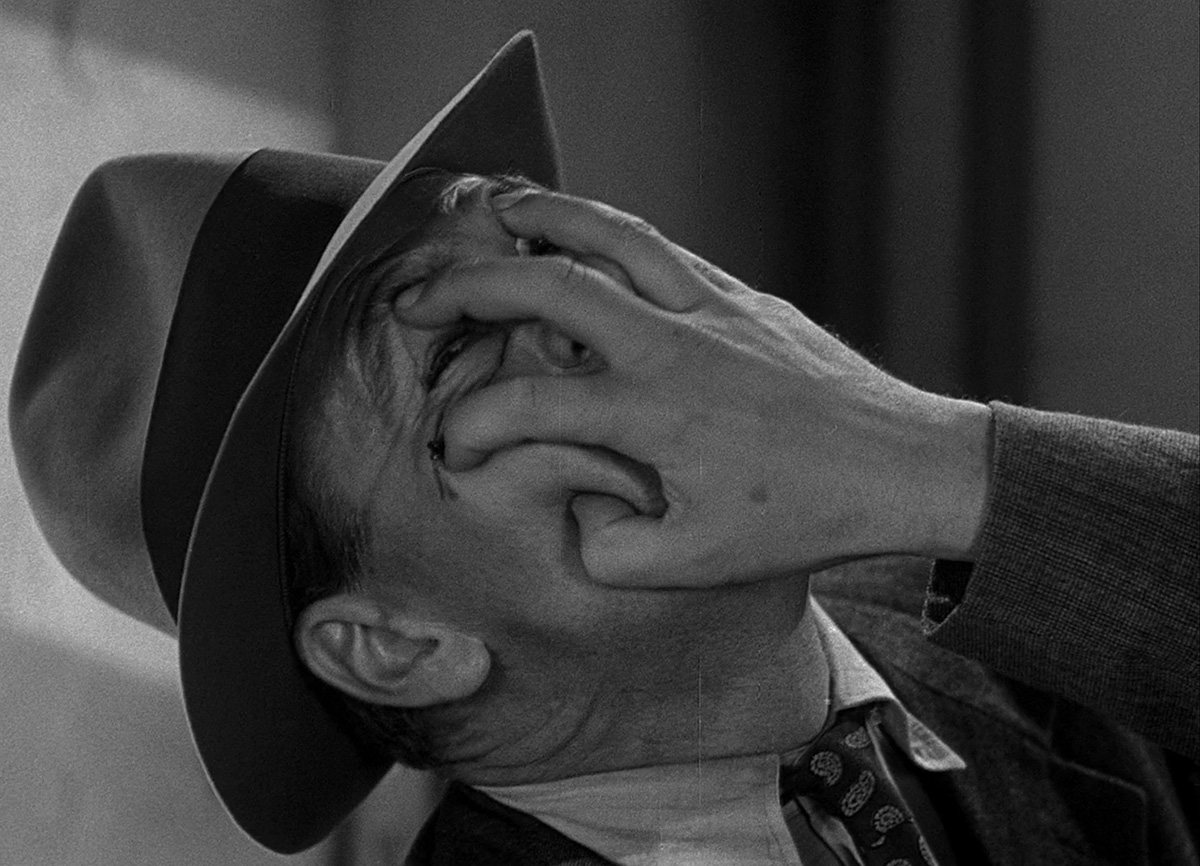

Giuseppe Boccassini
RAGTAG
Experimental film | dcp | color and b&w | 85:0 | Italy, Germany | 2022
An intriguing, well-chosen collage of compelling moments from noir cinema, skillfully attuned to the social fantastic and the oneiric quality of the films. James Naremore, author of More Than Night: Film Noir in Its Contexts. An atlas of film gestures and Pathosformel: the montage - better the disassembly - isolates moments from the narrative and separates bodies from events, opening up to the unthinkable and the invisible of film noir. Ragtag, thus, becomes an immense archive of the imaginary that, far from being sequential and historical, becomes intensive and organic: a film-experience beyond film as such. Federico Rossin, film historian.
Giuseppe Boccassini is an Italian filmmaker mainly working in Germany and Italy. He graduated in film theory at the University of Bologna and film direction at The New University of Cinema and Television, Cinecittà, Rome. His work has been shown in several international film festivals and exhibitions, including the 79th Mostra Internazionale d'Arte Cinematografica, Venice, Italy FID Marseille, France, Edinburgh International Film Festival, Scotland, Ji.hlava International Documentary Film Festival, Czech Republic, Jerusalem IFF, Torino Film Festival, Italy, IndieLisboa, Portugal, FESTACURTAS BH, Brasil, Crossroads SF, USA, Avvistamenti, Italy, Punto de Vista, Spain, Trentino History Museum, Italy, Microscope Gallery, Brooklyn, NY, Pesaro Film Festival, Italy. Light Cone Paris distributes his entire film production. By transforming and manipulating various sources of archival material, his work reflects upon the notion of proximity in contemporary media. The director considers film as "a phallic conquerer that, folding in on itself, now flaccid deus ex machina, observes itself from the inside like a lysergic membrane that slowly founders between the folds of its material." His most recent collaborations include the film editing for Aldo Tambellini's solo exhibition Black Matters at ZKM Karlsruhe, Germany, and he is the artist for Chicago Film Archives' 2018 Media Mixer. He is in charge of programming at Fracto Experimental Film Encounter held yearly at Kunsthaus Acud, in the heart of Berlin.
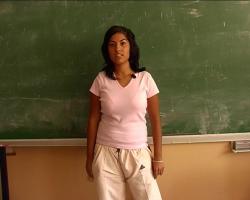

Katinka Bock
Dort ist überall und wir sind immer HIER
Experimental doc. | dv | color | 9:50 | Germany | 2005
LA-BAS, c'est partout, et nous sommes ICI. Vidéo en 16 chapitres (111 min.), 2005 Extrait (chapitre 1): ALAMANCI (9 min.) Le film "LA-BAS, c'est partout, et nous sommes ICI" est un documentaire sous forme d'interview consacré au thème du retour en Turquie de jeunes d'origine turque venant d'Allemagne. Les 14 personnes interrogées ont entre 15 et 40 ans, vivent à Berlin, Ankara ou Istanbul, sont turques, kurdes, allemandes ou simplement elles-mêmes. Leur point commun: tous sont les enfants ou les petits-enfants d'immigrés turcs, ont grandi en Allemagne et sont retournés en Turquie entre 12 et 20 ans. Le film montre des systèmes et des points de vue déterminés culturellement, et s'attache à dévoiler les strates politiques, personnelles et géographiques en mettant l'accent sur des mécanismes strcturels, et non individuels. Ceux qui sont rentrés sont confrontés à des questions d'identité, d'intégration, de délimitation, d'exclusion en Allemgne comme en Turquie, que les autres, restés sur place, ne se poseront jamais. Ils parlent dans le film de ce que signifient des mots comme ici et là-bas, partir et arriver, s'adapter et être à l'écart, être entre les deux. Au cours de la conversation, des notions évidentes disparaissent de notre géographie mentale: où est donc ICI? Quand étais-tu LA-BAS? Qui sont les AUTRES? Quel est le lien entre le propre déracinement culturel et le regard stigmatisant du monde extérieur? La dissolution du lieu et de l'appartenance culturelle se répercute dans la forme. Le lieu, la situation et l'individu ne se défninissent que par la parole et la présence d'un interlocuteur, pas par le lieu de tournage. Les 14 personnes parlent en 16 chapitres, chacun étant une clé pour comprendre un autre. Ce travail est comme un livre dont on peut lire indépendamment les chapitres.
Katinka Bock (née en 1976 à Francfort sur le Main) a étudié l'art et la sculpture à Berlin, Dresde et Paris (diplômée en 2002, master avec Inge Mahn en 2004). Elle a obtenu des bourses et des prix comme le Prix Marion-Ermer (2002) et le soutien aux jeunes artistes de la ville de Berlin en 2004. Elle termine actuellement son post-diplôme à l'ENBA de Lyon et sera accueillie en 2006 en résidence à La Box (Bourges). Katinka Bock vit et travaille à Berlin et Paris.


Sebastian Bodirsky
Kraft, Herrlichkeit
Experimental fiction | dv | color | 13:20 | Germany | 2005
"Kraft, Herrlichkeit" (Power, Glory) is the product of research on neo-conservative metaphors and ideology. It comments on a story by the contemporary German author Georg Klein, using and breaking the motifs of the story. The result is a disturbing fiction of glorified efficiency, flat hierarchies and the strong belief in the blessing of competition.
Sebastian Bodirsky, born in 1981, lives in Berlin. He is currently studying in the "Experimental Film" class of Professor Heinz Emigholz at the University of the Arts Berlin. He develops his film works based on reflections on knowledge, observation, and intervention.